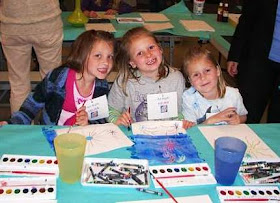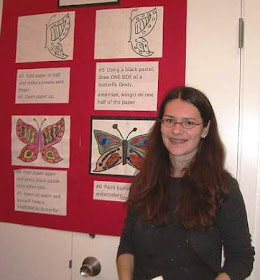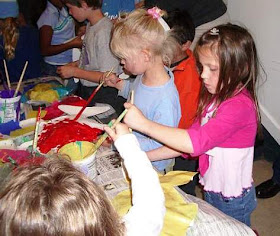
"I am planning a Family Art Event at my school. We are planning to have different stations set up for kids and their folks to experiment with different art materials and have fun making art together as a school. Have you ever had an event like this at your school? If you have and have any suggestions or advice, I will listen with grateful ears! I am trying to collect information and tips from other art teachers who have done something like this before. If you ever have a moment to share something you have learned from hosting art events, I would be so appreciative!"
Our school was lucky to have a forward-thinking principal who believed in the value of art even though test scores dictated a much different agenda. Still, I wasn't quite sure what an "Art Night" would involve, and was a little hesitant on my ability to pull off an event where children and parents could experience art together. The principal offered up her staff (a combination of regular classroom teachers and student aids) and together we brainstormed on lesson possibilities.
I don't have all my notes but I believe my list went something like this:
- Printmaking Station: Etch foam with a dull pencil, use a brayer to roll on paint. Print onto pre-cut 5" x 7" paper.
- Water Color and Oil Pastel Resist: Set out small pieces of paper, oil pastels and pans of watercolor paints and let kids free-paint.

- "Antique Flowers" Watercolor Wash: Use oil pastels to draw a vase with flowers. Crumple paper to form wrinkles. Cover with watercolor wash. Here is a lesson link.
- "Symmetrical Butterfly": Fold a piece of white paper in half, draw half a butterfly on one half with an oil pastel, fold over and press hard. Trace faint outline on other side and fill in with watercolor. Here is a lesson link.

- Stuffed Fish: Children select large fish shape and staple paper together. Paint with bright colors and add glitter. (One teacher was anointed "The Glitter Queen" and sprinkled glitter on the wet paint. A large table was needed for this project as well as large vats of pre-mixed paints, large brushes and plenty of staplers!

- Oil and Chalk Pastel Drawing: Children use oil pastels on pre-cut black paper then smudge chalk pastels over top.
- Symmetrical Vase with Stamped Flowers: Children cut a vase from pre-folded card stock and glue onto a small piece of paper. Using sponges (various shapes) dipped in paint, they stamped flowers and designs onto their paper. Here is a lesson link.

- Play-Dough Color Wheel: Children blend colors using yellow, red and blue play dough.
Set-up: This was a biggie. I knew it would be difficult to stage actual art demonstrations as people needed to be able to come and go freely. So to make the art project assessable to everyone, I created demo boards. I drew or created the "steps" in the art project and used MS Word to create printable instructions. The steps were easy to follow for anyone.There is an example above (Symmetrical Butterfly).
Art Storage: Once a child completed a project, what were we suppose to do with it? They couldn't quite carry it around as most of the projects remained wet for a while. One of the teachers suggested that we convert an unused portion of our cafeteria for art storage. This is what she suggested: Lay colored sheets of work paper along floor (as long as you can make them...about 20 feet). For each color, label the ends: LAST NAME A-C, LAST NAME D-F, etc. When a child finished a project they took the wet paper out to the paper row and placed their art under the initial of their last name. Each row was a different color so the child could remember what color he was. The system worked beautifully.
I hope this helps, Lisa! If any other art teachers have done anything similar, please weigh in. It'd be fun to hear different ideas and what worked and what didn't.

I LOOOOOOVE this idea! I am totally going to do this at my school! Did you let them leave their wet artwork overnight? This is such a great way to get parents involved!
ReplyDeleteI too wondered if they left their work...or took it home. Beautifully done by the way! I feel less intimidated by the whole process, so thank you!
ReplyDeleteP.S. It would be nice to see images of all of your posters, just to get an idea of wording and the directions for each of these projects!
ReplyDeleteYes, they took their work home at the end of the night. The whole idea behind the lengths of paper would be that it would make the sorting of the drying art easier.
ReplyDeleteAs for pictures of the boards...well, you guys need to do a few things on your own!
Here's is a 3-D project
ReplyDeletecalled Let's Build a Green City
that I produced for Family Fun Night
to celebrate Earth Day
It was fast, fun, and easy to clean up! Everyone brought recyclable goods. At the end, we took a group photo, everyone took home their piecesand we recycled the rest.
You just need tape!
http://www.flickr.com/photos/artyowza/sets/72157617696317017/
Wow- that is impressive! I will store this idea away for the future!
ReplyDeleteHere's another Family Fun Night idea where families made art together:
ReplyDeleteOur Amazing Planet
An hour before hand, I set up a materials buffet: Square Paper, Glue, Scissors and Markers.
A couple of weeks before, I sent home a list of material ideas. So, everyone brought Recyclable, Collage and Art Materials to share.
Over night, the artwork dried. Planning for their return, each artwork had a name and room number on the back. The next morning, I hung them on bulletin boards around school.
I had two people help me set up and the parents and children helped to clean up.
After a couple of months, a volunteer took down the display and distributed the pictures to the classrooms.
http://www.flickr.com/photos/artyowza/sets/72157622856385038/